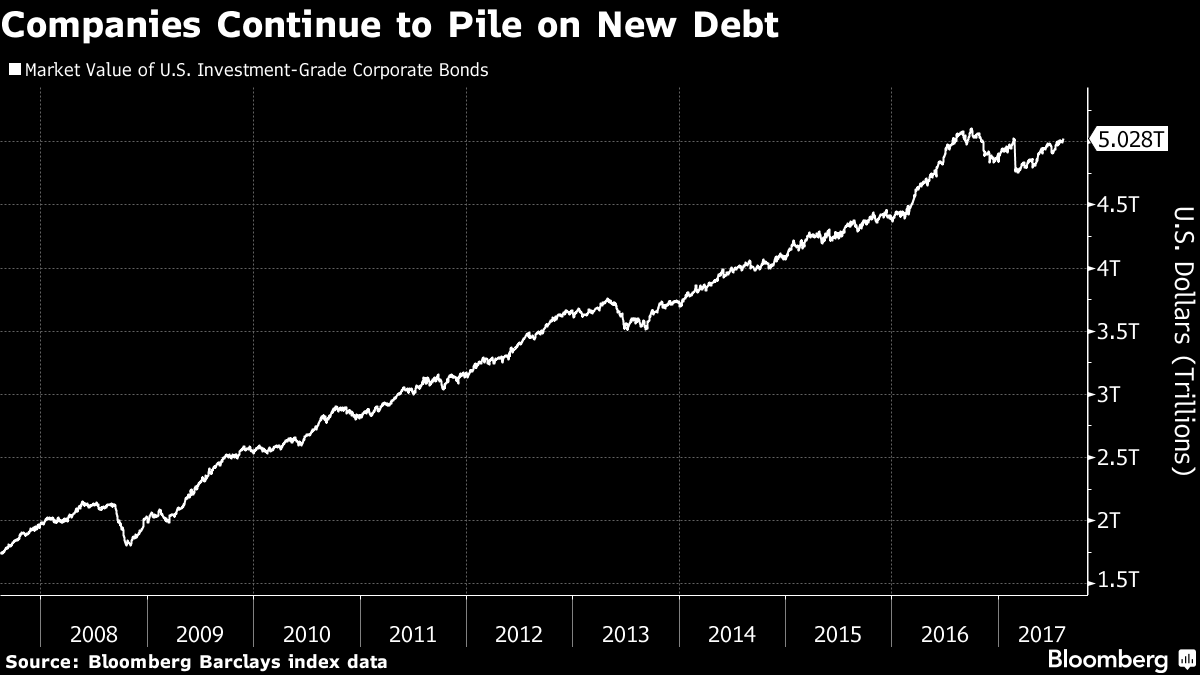And perhaps no case better illustrates the effervescence than Tesla. Investors overlooked its negative cash flow and repeated trips to capital markets to snap up its bonds, allowing the company to increase the size of the sale from the original $1.5 billion. It’s paying 5.3 percent on its new debt, a record low coupon for a bond of its rating and maturity.
Traces of froth are also starting to show up in M&A financing. Masayoshi Son’s SoftBank Group Corp., one of Japan’s most indebted companies, still was said to be able to line up as much as $65 billion in financing as it weighs a formal takeover offer for Charter Communications Inc. and looks to possibly merge it with Sprint Corp.
Charter already has $63 billion of debt on its balance sheet, while Sprint carries $40.9 billion. SoftBank has total debt of about $130 billion. Meanwhile, Son’s rival billionaire Patrick Drahi is working on his own potential offer to buy Charter, even though Charter’s market value is about double that of Drahi’s Altice NV and its U.S. unit combined.
Demand for extra spread amid flat or negative rates brought overseas investors in droves to U.S. credit, helping prop up the borrowing desires of companies eager for the cheap debt. Even with all the angst surrounding North Korea, U.S. corporate high-yield funds had their second consecutive week of inflows in the week ended Aug. 9, Lipper data showed.
“The one thing we are watching is how much money is flowing into credit markets from outside the U.S.,” said Ken Monaghan, Amundi Pioneer Director of Global High Yield. “Those investors aren’t buying Treasury bonds anymore -- they’re buying corporate bonds, both investment grade and high yield. One of the things that concerns us is to what extent that money will depart when rates rise overseas.”
Elsewhere, there are signs risks are being overlooked. U.S. high-yield bonds sold in June contained the weakest protections for lenders of securities issued in any single month on record, according to a July 11 report from Moody’s Investors Service.
“The thing you miss unless you step back: we’re just seeing a lot of issuance,” Tannuzzo said. “Valuations are very extended.”
“That Tesla could come to the market at a little over 5 percent yield for a low-single B rated company, is something of a sign of exuberance,” said Gene Tannuzzo, senior portfolio manager at Columbia Threadneedle, with about $467 billion under management. “Elon Musk is a pretty cool guy but they haven’t figured out how to make money yet and that’s not a lot of yield.”

Foreign Buyers
And overlooking it all is the pervasive niggle that comes with a growing debt pile. For all the indications of strain within, that shouldn’t be overlooked, according to Columbia Threadneedle’s Tannuzzo. Companies have sold $968 billion of investment-grade notes this year. Leverage ratios, a measure of debt to earnings, are near their highest since before the crisis for non-financial firms in the S&P 500.








